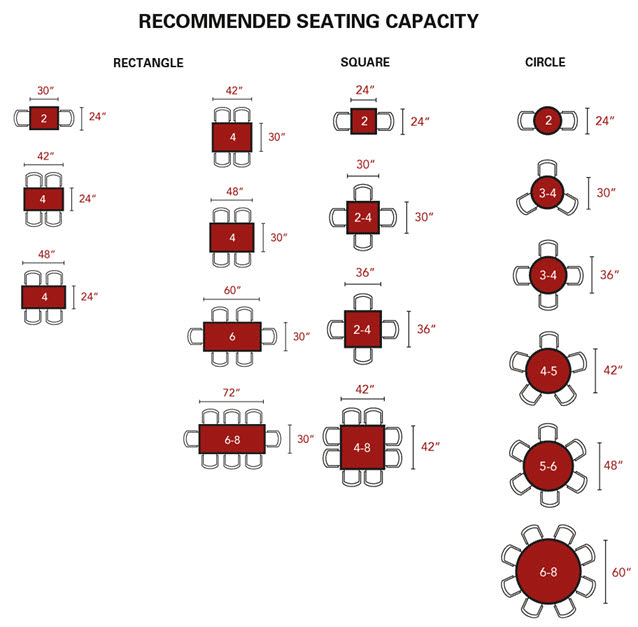Is the Number of People in a Restaurant That Has a Capacity of 150discrete ora Continuous

When designing your restaurant, you must take in to account your venue's seating layout. Picking the correct table shape and size can determine your restaurant's capacity and ultimately your sales.
Each diner requires a minimum of 24" of space in terms of the width. This will provide ample space between the chairs to allow customers to get in and out and sit in comfort. An addition important aspect to consider when choosing tables is the type of restaurant you have. For full course meals a 30"x30" table will comfortably serve only 2 seated customers. However, a café or an ice-cream restaurant could seat 4 customers on the same table size.
For instance, a fast food chain or a café may use tables that measure by 30" X 42" or 1,260 square inches. When you divide that dimension by 300 square inches per diner, you can potentially have enough table space to fit 4 people. However, there are other matters to factor in when trying to determine the table bases & table size you need.
ARE ROUND OR RECTANGULAR TABLES MORE SPACE EFFICIENT?
Square or rectangular restaurant table tops make it easier to join tables together when large parties come in therefore making them more popular among restaurateurs. Round table are preferred in cafes due to the ability to seat more people at one table where chairs can be 'squeezed' around them. A good combination of the two may be the best option depending on the space available and budget constraints.
Determining your maximum seating capacity depends on a number of factors such as the number and size of exists. You should also follow regulations in regards to aisle width and number of square feet allotted per guest. Doing so involves measuring the dining space. Multiplying the length times the width can help you find the square footage for a rectangular area. Measure the adjoining areas or alcoves if any and calculate the square footage.
Allocating space for wait stations can also help with your restaurant table arrangements. A small wait station only needs 6 to 10 feet while larger stations may require up to 40 feet. Measurements should be made on other areas of the restaurant where customers won't be seated immediately such as a decorative fountain or waiting area. That necessitates subtracting the square footage of that area from the total area of the dining room to find the amount of space available to seat customers.
WHAT NUMBER OF PEOPLE CAN SIT AT EACH TABLE SIZE?
Below is a seating capacity guide with various restaurant table types and sizes that is based on industry standards. A table's capacity may change depending on the type of venue and menu style.
| Standard Table Dimension | Total Seats / People |
|---|---|
| SQUARE TABLES | |
| 24" x 24" | 2 |
| 30" x 30" | 2-4 |
| 36" x 36" | 4 |
| 42" x 42" | 4-6 |
| 48" x 48" | 8 |
| ROUND TABLES | |
| 24" | 2 |
| 30" | 3-4 |
| 36" | 3-4 |
| 42" | 4-5 |
| 48" | 5-6 |
| 60" | 8-10 |
| 72" | 10 |
| RECTANGULAR TABLES | |
| 24" x 30" | 2 |
| 24" x 42" | 4 |
| 24" x 48" | 4 |
| 30" x 42" | 4 |
| 30" x 60" | 6 |
| 30" x 72" | 6-8 |
The diagram below visualizes the seating capacity of various restaurant table sizes.

Design Layout Considerations
Menus and the interior design are also important components of you table seating plan. Some venues may need more space to accommodate more utensils, plates, and service. The number of trays being used in cafeterias is one example. A family-style dining motif be it Mexican or Italian may need more plating. Table size which is calculated by the table top and base, is a critical aspect that helps you determine the likelihood of your patrons having a comfortable and enjoyable dining experience. Table sizes that are not proportional with the restaurant chairs overall or with the size of dining space can be off-putting to patrons. On top of poor service, furniture that is of low quality or doesn't sync with the décor can generate terrible reviews of your establishment.
A Break Down of Table and Chair Spacing:
- 14 square foot per person allows enough space for chairs, tables, and aisle.
- 12 square foot table is recommended for a cafeteria or restaurant style seating.
- 10 square table is suitable for a banquet hall, institution or closed seating.
- 18 inches is needed for a person seated at the edge of the table to the back of the chair.
- Diagonal seating can save a lot of floor space.
- Deuce tables and wall space allows more room.
- Minimum of 42 inches needed between square tables and chairs.
- Minimum of 54" inches for round tables and service space.
- With limited space, booths need to measure 8 ft. square feet per person including aisle space.
Dimensions for comfortable seating may need adjustments when considering seating options for things like arm rests, foot rests, etc.
Implementing Damage Control
As a restaurateur or a manager of a commercial establishment, ensuring a sufficient amount of seating and table space without having a crowded room should be your priority. The right table size and shape can reduce wait time for hungry diners. Monitoring traffic flow is also essential since congestion in busy establishments can increase noise pollution, result in accidents, and slow down services. An illustrative table seating chart can help you with your design process.
finkbeinerript2000.blogspot.com
Source: https://www.restaurant-furniture.com/resources/guides/restaurant-seating-capacity-guide/
0 Response to "Is the Number of People in a Restaurant That Has a Capacity of 150discrete ora Continuous"
Post a Comment